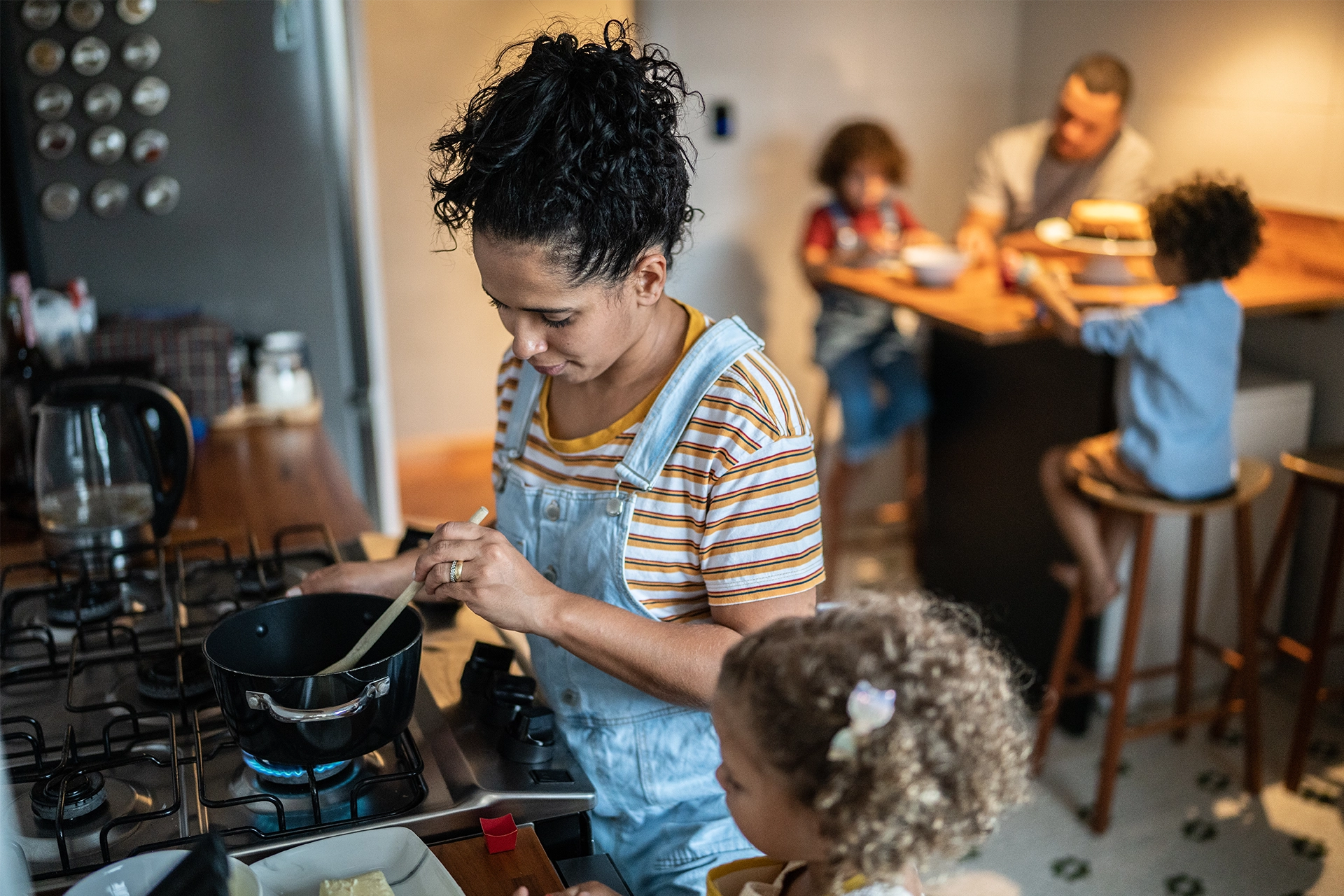
Politics & Society
Life for single-parent families in Australia is harsh

While women are spending more of their time earning a wage, men aren’t doing more housework, finds the latest HILDA Survey
Published 6 March 2025
Housework, child care, caring for elderly or disabled relatives, and work to keep the home running are still largely women’s work in Australia.
This is despite the fact that, during the past 20 years, women have been working longer hours in paid employment.

In 2002, on average, women spent more time on housework than on paid work – 23.8 hours versus 22.2 hours. However, twenty years later, the tables have turned and in 2022, women averaged 28.5 hours per week in paid employment and spent 18.4 hours of their week doing housework.
The latest annual report based on data from the Household, Income and Labour Dynamics in Australia (HILDA) Survey shows that, in total, women are spending around 8.2 hours a day on paid work, housework and caring for family.
But while women are spending more of their time in work outside the home, the number of hours that men spent on housework has stagnated.
The HILDA report reveals that men’s involvement in housework has changed very little and in 2022, men spent an average of 12.8 hours on housework per week – about the same amount of time as 20 years earlier.

Politics & Society
Life for single-parent families in Australia is harsh
The HILDA Survey follows the lives of more than 17,000 Australians each year, over the course of their lifetime, and collects information on many aspects of life in Australia including household and family relationships, income and employment, health and education.
The latest HILDA data shows that while men spend 37.9 hours per week on employment, women spend 28.5 hours in paid work.
But women are still doing about 18.4 hours of housework per week, compared to 12.8 hours for men. Women also spend 8.8 hours caring for their own children compared to 4.5 hours for men.
“It’s become the norm for men and women to be employed. Women are highly educated and they want to make use of their education.
"The declining fertility rates also mean women return to the labour market faster,” says Dr Inga Lass, Senior Research Fellow at the Melbourne Institute: Applied Economic & Social Research, at the University of Melbourne.

“Also, in many countries, like Australia, many couples can only maintain living standards and manage the cost of living if both partners are working.”
When children arrive in a household, how much time a couple spends on paid and unpaid work increases significantly.
In 2022, couples without children spent an average of about 108 hours per week on paid and unpaid work, but for couples with children, that figure was closer to 144 hours per week.
According to the findings from the HILDA report, couples without children more equally divide work inside and outside home.
Women in childless couples accounted for about 44 per cent of the total time a couple spent on employment and 56 per cent of the time they spent on housework.

In contrast, couples with children had a more gendered division of labour.
Women’s share of time spent on paid work was only about 36 per cent but they accounted for 59 per cent of housework time and 62 per cent of caring time.
In couples where both partners work full-time, the lack of balance was still apparent with women’s housework and caring time sitting at 55 and 56 per cent respectively.
Dr Lass can only speculate on why housework is still perhaps viewed as predominantly ‘women’s work’.

“Men still seem to get around doing more of the routine housework tasks, and that may be because there’s no incentive for them. Housework isn’t valued as highly and it does not provide the same rewards as paid work or spending time with your children.
“And if the house is a bit messy or the kids have stains on their clothes, people tend to blame the woman."
HILDA data clearly illustrates that the arrival of a first child is a catalyst that widens the labour divide between couples.
Five years before the arrival of a first baby, each partner’s share of time spent on paid and unpaid work is comparatively equal – with men spending slightly more time on employment (53 per cent) and women more time on housework (54 per cent).
The first birth dramatically unsettles this balance.

Politics & Society
It’s getting easier to become a problem gambler in Australia
Women’s share of paid work in a couple falls from 46 per cent three years prior and 39 per cent one year prior to birth to 16 per cent immediately after the birth.
Meanwhile, a woman’s share of care rises sharply to 71 per cent in the first year after her baby’s birth and her share in housework climbs to 63 per cent.
“The birth of the first child is a turning point in a couple’s division of labour, and it has a long-lasting impact,” says Dr Lass.
“Women usually go on maternity leave and become responsible for much of the childcare and housework.

“Men usually only briefly take leave and continue in their job, perhaps working longer hours to meet increased financial responsibilities.
"Because that arrangement is quite efficient, it sticks.
While this may be expected in the months or early years after a new baby’s arrival, the gender division doesn’t diminish as that child grows up.
Five years after the birth of a first child, a woman’s share of paid work is only 26 per cent, rising to 33 per cent a decade after the birth.
Women’s share of housework also remains high at 62 per cent.
“If a woman returns to the labour market, she still keeps doing much of what she has been doing at home as well. Most of those tasks still fall on her shoulders. It becomes a pattern that isn’t renegotiated,” says Dr Lass.

Business & Economics
Australia’s weather-related disasters are getting costlier
Perhaps not surprisingly, men are more satisfied with the division of labour.
In 2005, men rated their satisfaction with housework and childcare tasks at an average of 8.0 and 7.9 out of 10.
Women’s satisfaction levels were 6.9 and 7.3 respectively.
However, the onset of the COVID-19 pandemic and its accompanying lockdowns, online teaching and remote working arrangements saw those ratings decline in 2022 – reaching an all-time low for men of 7.6 and 7.7.
HILDA data show that women’s satisfaction with the division of housework and child care mostly improves when the first child becomes a teenager.
But even then, women aren’t as happy with housework arrangements as they were before the first child arrived.

There’s also a clear satisfaction mismatch between couples.
The majority of women with children (62.6 per cent) felt they did a bit or much more than their fair share of housework.
This compares with 55.6 per cent of men with dependent children who felt they did their fair share around the house, and 17 per cent of men who believed they did a bit more – or much more – than their fair share of household chores.
“The perceptions of men and women as to whether they do or don’t do their fair share are diverse.
"In the same couple, women feel overly burdened and men think they are doing enough at home – they don’t see a problem,” says Dr Lass.